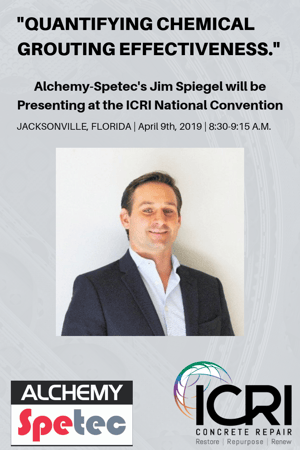
Alchemy-Spetec's Jim Spiegel will be presenting at the ICRI National Convention at the Omni Jacksonville Hotel on Tuesday, April 9th, 2019 from 8:30-9:15am. The topic of the technical session will be,
Quantifying Chemical Grouting Effectiveness. During this technical session, attendees can learn about an innovative and new approach to chemical grouting leak seal applications with insights through industry norms, new technologies, and case studies implementing these systems.
Jim currently sits on the National ICRI Board of Directors as an at-large member, and has served a 2-year term as Southern CA Chapter President. He is active in the 710.e Grouting, Certification, and Education Committees.
Want more info on Alchemy-Spetec products?
Topics:
All Posts,
Seal Leaks,
Business Tips

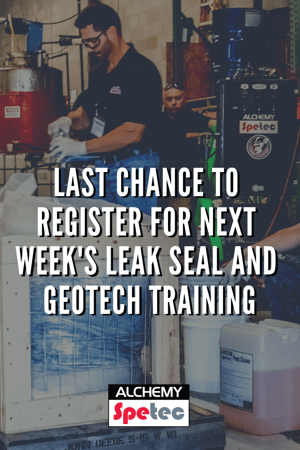
Leak Seal & Geotech Products & Procedures
March 14 & 15, 2019 at Alchemy-Spetec HQ in Tucker, GA
Last chance to register!
Get ready for a thorough education in Leak Seal, Slab Lifting, Soil Stabilization and the Alchemy-Spetec Deep Lift™ process. You’ll get hands-on training from a technical staff with decades of on-the-job experience.
Thursday - Leak Seal
- Leak Seal Product Line Overview
- Curtain Grouting
- Permeation Grouting
- Leak-Seal Product Mixing
- Pump & Packer Overviews
- Leak-Seal Accessories
- Municipal Applications
- Live Injection Demos
- Open Discussions
Friday - Geotech
- Geotech Product Line Overview
- Soil Stabilization
- Geotech Product Mixing
- Rig & Mobile System Overviews
- Geotechnical Accessories
- Slab Lifting Live Demo
- Deep Lift™ Overview
- Soil Testing with the
- GPR & Penetrometer
- Maintenance Discussions
- Pricing / Estimating / Cost Savings
- Open Discussions

Participants receive a Samsung tablet loaded with training material.
Your Instructors:
Stephen C. Barton (President/CEO), Jim Spiegel (VP Sales & Business Development), Andy Powell (Southeastern Regional Manager), Anthony Sandone (Eastern Regional Manager), and Charlie Lerman (Western Regional Manager). Each instructor is a seasoned professional with at least a decade of experience in the industry.
Topics:
Repair Seawalls,
Equipment & Accessories,
All Posts,
Lift Slabs,
NSF Certification,
Seal Leaks,
Stabilize Soil,
Business Tips,
Repair Cracks,
Waterstop,
Deep Lift,
Floor Repair


Leak Seal & Geotech Products & Procedures
March 14 & 15, 2019 at Alchemy-Spetec HQ in Tucker, GA
Balance your skill set with Leak Seal AND Geotech training!
Get ready for a thorough education in Leak Seal, Slab Lifting, Soil Stabilization and the Alchemy-Spetec Deep Lift™ process. You’ll get hands-on training from a technical staff with decades of on-the-job experience.
Thursday - Leak Seal
- Leak Seal Product Line Overview
- Curtain Grouting
- Permeation Grouting
- Leak-Seal Product Mixing
- Pump & Packer Overviews
- Leak-Seal Accessories
- Municipal Applications
- Live Injection Demos
- Open Discussions
Friday - Geotech
- Geotech Product Line Overview
- Soil Stabilization
- Geotech Product Mixing
- Rig & Mobile System Overviews
- Geotechnical Accessories
- Slab Lifting Live Demo
- Deep Lift™ Overview
- Soil Testing with the
- GPR & Penetrometer
- Maintenance Discussions
- Pricing / Estimating / Cost Savings
- Open Discussions

Participants receive a Samsung tablet loaded with training material.
Your Instructors:
Stephen C. Barton (President/CEO), Jim Spiegel (VP Sales & Business Development), Andy Powell (Southeastern Regional Manager), Anthony Sandone (Eastern Regional Manager), and Charlie Lerman (Western Regional Manager). Each instructor is a seasoned professional with at least a decade of experience in the industry.
Topics:
Repair Seawalls,
Equipment & Accessories,
All Posts,
Lift Slabs,
NSF Certification,
Seal Leaks,
Stabilize Soil,
Business Tips,
Repair Cracks,
Waterstop,
Deep Lift,
Floor Repair

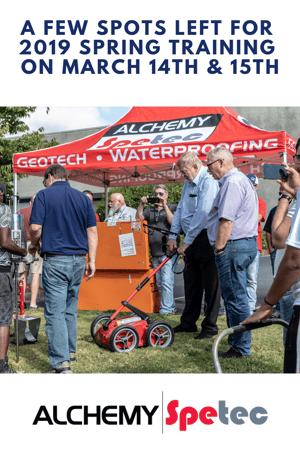
Leak Seal & Geotech Products & Procedures
March 14 & 15, 2019 at Alchemy-Spetec HQ in Tucker, GA
Only a few spots left!
Get ready for a thorough education in Leak Seal, Slab Lifting, Soil Stabilization and the Alchemy-Spetec Deep Lift™ process. You’ll get hands-on training from a technical staff with decades of on-the-job experience.
Thursday - Leak Seal
- Leak Seal Product Line Overview
- Curtain Grouting
- Permeation Grouting
- Leak-Seal Product Mixing
- Pump & Packer Overviews
- Leak-Seal Accessories
- Municipal Applications
- Live Injection Demos
- Open Discussions
Friday - Geotech
- Geotech Product Line Overview
- Soil Stabilization
- Geotech Product Mixing
- Rig & Mobile System Overviews
- Geotechnical Accessories
- Slab Lifting Live Demo
- Deep Lift™ Overview
- Soil Testing with the
- GPR & Penetrometer
- Maintenance Discussions
- Pricing / Estimating / Cost Savings
- Open Discussions

Participants receive a Samsung tablet loaded with training material.
Your Instructors:
Stephen C. Barton (President/CEO), Jim Spiegel (VP Sales & Business Development), Andy Powell (Southeastern Regional Manager), Anthony Sandone (Eastern Regional Manager), and Charlie Lerman (Western Regional Manager). Each instructor is a seasoned professional with at least a decade of experience in the industry.
Topics:
Repair Seawalls,
Equipment & Accessories,
All Posts,
Lift Slabs,
NSF Certification,
Seal Leaks,
Stabilize Soil,
Business Tips,
Repair Cracks,
Waterstop,
Deep Lift,
Floor Repair

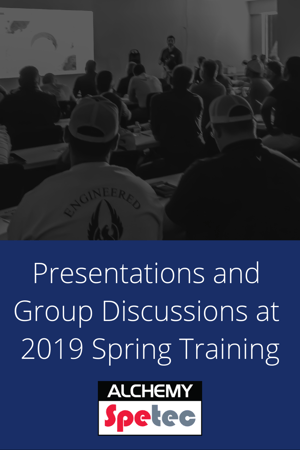
Leak Seal & Geotech Products & Procedures
March 14 & 15, 2019 at Alchemy-Spetec HQ in Tucker, GA
The best classroom learning in the business!
Informative presentations and group discussions packed with practical application instructions, business tips and more.
Get a thorough education in Leak Seal, Slab Lifting, Soil Stabilization and the Alchemy-Spetec Deep Lift™ process. You’ll also get hands-on training from a technical staff with decades of on-the-job experience.
Thursday - Leak Seal
- Leak Seal Product Line Overview
- Curtain Grouting
- Permeation Grouting
- Leak-Seal Product Mixing
- Pump & Packer Overviews
- Leak-Seal Accessories
- Municipal Applications
- Live Injection Demos
- Open Discussions
Friday - Geotech
- Geotech Product Line Overview
- Soil Stabilization
- Geotech Product Mixing
- Rig & Mobile System Overviews
- Geotechnical Accessories
- Slab Lifting Live Demo
- Deep Lift™ Overview
- Soil Testing with the
- GPR & Penetrometer
- Maintenance Discussions
- Pricing / Estimating / Cost Savings
- Open Discussions

Participants receive a Samsung tablet loaded with training material.
Your Instructors:
Stephen C. Barton (President/CEO), Jim Spiegel (VP Sales & Business Development), Andy Powell (Southeastern Regional Manager), Anthony Sandone (Eastern Regional Manager), and Charlie Lerman (Western Regional Manager). Each instructor is a seasoned professional with at least a decade of experience in the industry.
Topics:
Repair Seawalls,
Equipment & Accessories,
All Posts,
Lift Slabs,
NSF Certification,
Seal Leaks,
Stabilize Soil,
Business Tips,
Repair Cracks,
Waterstop,
Deep Lift,
Floor Repair

Leak Seal & Geotech Products & Procedures
March 14 & 15, 2019 at Alchemy-Spetec HQ in Tucker, GA
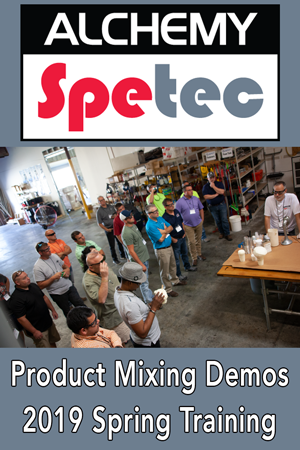 See live product mixing demos!
See live product mixing demos!
Get a thorough education in Leak Seal, Slab Lifting, Soil Stabilization and the Alchemy-Spetec Deep Lift™ process. You’ll also get hands-on training from a technical staff with decades of on-the-job experience.
Thursday - Leak Seal
- Leak Seal Product Line Overview
- Curtain Grouting
- Permeation Grouting
- Leak-Seal Product Mixing
- Pump & Packer Overviews
- Leak-Seal Accessories
- Municipal Applications
- Live Injection Demos
- Open Discussions
Friday - Geotech
- Geotech Product Line Overview
- Soil Stabilization
- Geotech Product Mixing
- Rig & Mobile System Overviews
- Geotechnical Accessories
- Slab Lifting Live Demo
- Deep Lift™ Overview
- Soil Testing with the
- GPR & Penetrometer
- Maintenance Discussions
- Pricing / Estimating / Cost Savings
- Open Discussions

Participants receive a Samsung tablet loaded with training material.
Your Instructors:
Stephen C. Barton (President/CEO), Jim Spiegel (VP Sales & Business Development), Andy Powell (Southeastern Regional Manager), Anthony Sandone (Eastern Regional Manager), and Charlie Lerman (Western Regional Manager). Each instructor is a seasoned professional with at least a decade of experience in the industry.
Topics:
Repair Seawalls,
Equipment & Accessories,
All Posts,
Lift Slabs,
NSF Certification,
Seal Leaks,
Stabilize Soil,
Business Tips,
Repair Cracks,
Waterstop,
Deep Lift,
Floor Repair

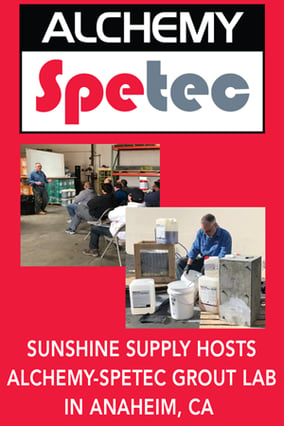
Leak seal product distributor Sunshine Supply, headquartered in California, hosted a well-attended Alchemy-Spetec Grout Lab today for local contractors in the Anaheim area. The curriculum included…
Classroom Polyurethane Leak Seal Training
- Safety Considerations for Polyurethane Leak Seal Work
- Crack Injection Products and Application Procedures
- Curtain Grouting Products and Application Procedures
Live Polyurethane Leak Seal Demos
- Concrete Crack Injection
- Curtain Grouting
- Pump Startup and Maintenance
Watch this brief clip (from a demo at the grout lab) of a crack cross section showing off-gassing pressures creating full depth repair...
Want an Alchemy-Spetec leak seal grout lab in your area? Find your local product distributor and ask them to call us!
Don’t want to wait? Travel to the Atlanta area for the next Alchemy-Spetec contractor training on March 14th and 15th at our headquarters. Click here for more information on the Atlanta-area training program!
Want more info on Alchemy-Spetec leak seal products?

Topics:
All Posts,
Seal Leaks


Leak seal product distributor Sunshine Supply, headquartered in San Diego, hosted a well-attended Alchemy-Spetec Grout Lab today for local contractors in the area. The curriculum included…
Classroom Polyurethane Leak Seal Training
- Safety Considerations for Polyurethane Leak Seal Work
- Crack Injection Products and Application Procedures
- Curtain Grouting Products and Application Procedures
Live Polyurethane Leak Seal Demos
- Concrete Crack Injection
- Curtain Grouting
- Pump Startup and Maintenance
Want an Alchemy-Spetec leak seal grout lab in your area? Find your local product distributor and ask them to call us!
Don’t want to wait? Travel to the Atlanta area for the next Alchemy-Spetec contractor training on March 14th and 15th at our headquarters. Click here for more information on the Atlanta-area training program!
Want more info on Alchemy-Spetec leak seal products?

Topics:
All Posts,
Seal Leaks


Get ready for a thorough education in polyurethane leak seal products and applications on Thursday, March 14th (March 15th is geotech day), 2019 at Alchemy-Spetec HQ in Tucker, GA. You’ll get hands-on training from a technical staff with decades of on-the-job experience. Registration includes both days, but we’ll take a close look at the leak seal curriculum in today’s blog post…
The schedule on Thursday, March 14th includes presentations on the Alchemy-Spetec leak seal product line, crack injection, curtain grouting, permeation grouting, pumps & packers, leak seal accessories and municipal applications. There will also be live injection demos, product mixing demos, and open discussions for sharing job related tips and solutions from the field.
Your instructors have years of experience providing technical support for both contractors and distributors across the country. You can look forward to presentations, demos and/or discussions lead by Stephen C. Barton (President/CEO), Jim Spiegel (VP Sales & Business Development), Andy Powell (Southeastern Regional Manager), Anthony Sandone (Eastern Regional Manager), and Charlie Lerman (Western Regional Manager).
Participants will receive a Samsung tablet loaded with leak seal training material.
The registration deadline is February 28th.
Sign up while there's still space available...

Topics:
All Posts,
Seal Leaks,
Business Tips

The dreaded floor/wall leak. Anyone who has seen enough leaks in their time knows that the wall/floor detail can be an injection contractors arch-nemesis. But it doesn't have to be so difficult. Please take a look at the basic detail depicted in the graphic which shows a common mistake as well as a couple of ways to remedy this situation with chemical grouting. Alchemy-Spetec has several products that can be used for this application. For an explanation of when and why you would use
Spetec PUR H100,
Spetec PUR F400,
Spetec AG200, or
Spetec PUR GT500, please call us at
404-618-0438, or click the button at the bottom of this article to schedule a consultation with a technical consultant.
See a close up of the graphic and an overview of the drilling methods below:
Top Arrow: The location of the top arrow in the graphic represents a good drilling technique, but it requires depths that many contractors are not used to drilling for joint injection. Drilling here is very effective when grout is delivered to the positive side of the footer joint.
Middle Arrow: Drilling a shallow hole that does not reach the joint here (see how the arrow stops mid-wall?) is the most common mistake when doing footer details. The contractor thinks they are hitting a wall/floor joint that is not there. Often they damage existing waterstops in good condition if they do reach the joint. However, drilling here can be effective if the joint is actually reached and the grout is injected successfully.
 Bottom Arrow:
Bottom Arrow: This is the least commonly used drilling location, but when done correctly it seals the under-slab leak path as well as the wall/footer leak path. It's the least intuitive because it requires specific knowledge of the footer construction.
Want to schedule an appointment with an Alchemy-Spetec tech consultant to learn more about this process?
Topics:
All Posts,
Seal Leaks

 Alchemy-Spetec's Jim Spiegel will be presenting at the ICRI National Convention at the Omni Jacksonville Hotel on Tuesday, April 9th, 2019 from 8:30-9:15am. The topic of the technical session will be, Quantifying Chemical Grouting Effectiveness. During this technical session, attendees can learn about an innovative and new approach to chemical grouting leak seal applications with insights through industry norms, new technologies, and case studies implementing these systems.
Alchemy-Spetec's Jim Spiegel will be presenting at the ICRI National Convention at the Omni Jacksonville Hotel on Tuesday, April 9th, 2019 from 8:30-9:15am. The topic of the technical session will be, Quantifying Chemical Grouting Effectiveness. During this technical session, attendees can learn about an innovative and new approach to chemical grouting leak seal applications with insights through industry norms, new technologies, and case studies implementing these systems. 












 See live product mixing demos!
See live product mixing demos!






 The dreaded floor/wall leak. Anyone who has seen enough leaks in their time knows that the wall/floor detail can be an injection contractors arch-nemesis. But it doesn't have to be so difficult. Please take a look at the basic detail depicted in the graphic which shows a common mistake as well as a couple of ways to remedy this situation with chemical grouting. Alchemy-Spetec has several products that can be used for this application. For an explanation of when and why you would use
The dreaded floor/wall leak. Anyone who has seen enough leaks in their time knows that the wall/floor detail can be an injection contractors arch-nemesis. But it doesn't have to be so difficult. Please take a look at the basic detail depicted in the graphic which shows a common mistake as well as a couple of ways to remedy this situation with chemical grouting. Alchemy-Spetec has several products that can be used for this application. For an explanation of when and why you would use  Bottom Arrow: This is the least commonly used drilling location, but when done correctly it seals the under-slab leak path as well as the wall/footer leak path. It's the least intuitive because it requires specific knowledge of the footer construction.
Bottom Arrow: This is the least commonly used drilling location, but when done correctly it seals the under-slab leak path as well as the wall/footer leak path. It's the least intuitive because it requires specific knowledge of the footer construction. 
